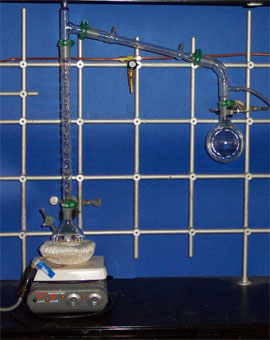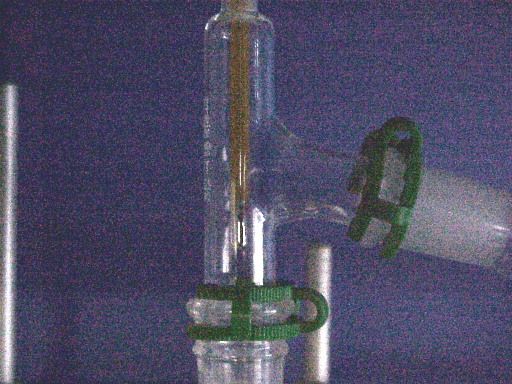

last updated


The left picture shows a standard distillation setup for fractionated distillation i..e. cracking of dicyclopentadiene. It consists of a Schlenk flask, a Vigreux column, a three-way distilling head, a Liebig condenser, a vacuum adapter and a receiving flask. Here are a few points to be considered:
1. The setup affords a significant amount of space (~1/2 fume hood) and therefore should be place on one side of the fume hood and not in the middle. The setup has to be straight.
2. The best way to clamp the setup is at the neck of the flask which contains the liquid in the beginning and the neck of the receiving flask. The clamps have to have the proper size and still have their rubber tips. Additionally, the Liebig condenser or the Vigreux column can be lightly clamped to keep the setup from tipping over. Excessive use of clamps usually causes a lot of strain, and ultimatively breakage because there are too many fixed points.
3. The Vigreux column that serves the purpose of separating out compounds of different boiling points. The closer the boiling points, the longer the column has to be in order to accomplish satisfactory separation (see petrol industry).
4. The three-way distilling head connects it to a Liebig condenser, which allows you to condense the vapors. The thermometer on top measures the temperature of the vapor right before it condenses (boiling point). Make sure that the mercury/alcohol part is sufficiently immersed into the vapors. The blow up on the right side shows three-way distilling head with the thermometer bulb in the correct position.
5. At the end of the condenser, a vacuum adapter is attached, where another Schlenk flask serves as a receiving flask for the distillate. The outlet of the vacuum adapter is attached to the vacuum, the Schlenk line or a bubbler.
6. In order to obtain a good seal during the drying and a reaction, all tapered joints have to be lubricated lightly. The laboratory course uses high vacuum grease from Dow Corning. This grease is stable up to ~200oC and dissolves in most common solvents like tetrahydrofuran, diethyl ether, pentane, dichloromethane, etc.
7. A heating mantle, water bath, oil bath or sand bath serves as a heat source for the distillation, depending on which temperature you need. If the boiling point of the compound is too high (Tb>150 oC), a vacuum distillation shoudl be used.
8. During the distillation, water has to be circulate in the condenser (inlet from water supply: lower end, outlet to sink: upper end).
9. Lastly, a spin bar has to be added to the flask to mix the solution during the distillation.